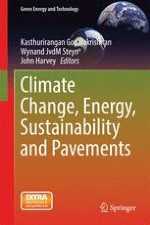
2014 | OriginalPaper | Buchkapitel
1. Pavement Life Cycle Assessment
verfasst von : Yue Huang, Tony Parry
Erschienen in: Climate Change, Energy, Sustainability and Pavements
Verlag: Springer Berlin Heidelberg
Aktivieren Sie unsere intelligente Suche, um passende Fachinhalte oder Patente zu finden.
Wählen Sie Textabschnitte aus um mit Künstlicher Intelligenz passenden Patente zu finden. powered by
Markieren Sie Textabschnitte, um KI-gestützt weitere passende Inhalte zu finden. powered by